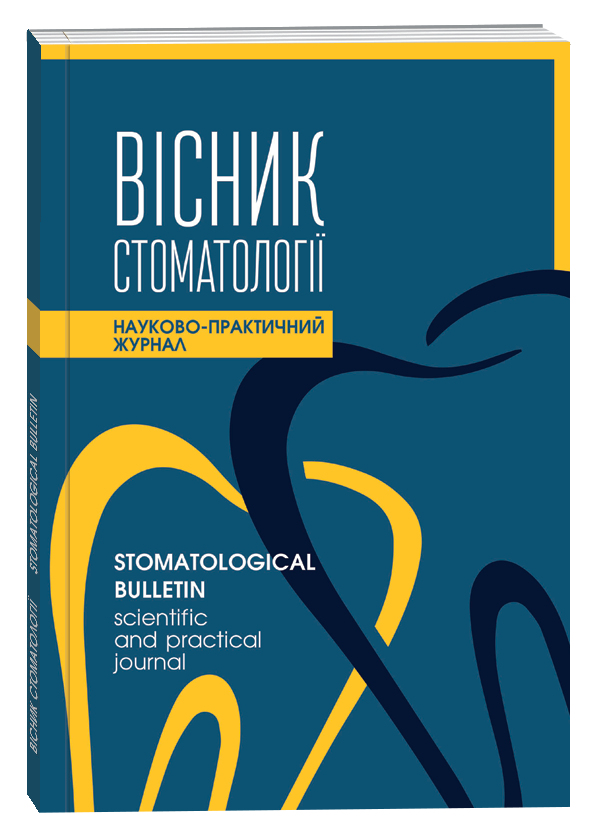HYPERSENSITIVITY OF HARD DENTAL TISSUES IN PATIENTS AFTER PROFESSIONAL OFFICE BLEACHING AND METHODS OF ITS TREATMENT
DOI:
https://doi.org/10.35220/2078-8916-2021-42-4.4Keywords:
hypersensitivity of teeth, desensitizers, professional bleaching, clinical efficiencyAbstract
Purpose of the study. Study the clinical efficiency of using different groups of desensitizers to reduce the hypersensitivity of teeth in patients after office bleaching procedure. Methods of the study. We examined 56 patients with dental hard tissues hyperesthesia, who were divided into two equal groups, depending on which desensitizer was used to reduce manifestations of dental hypersensitivity. In persons of group I we used desensitizer based on organic resins, in patients of group II –desensitizer that capable to form oxalate salts on dental hard tissues. The efficiency of two groups desensitizers application in different terms of observation is estimated, changes of prevalence and intensity of hyperesthesia ranks are shown. Results. The overall clinical efficiency of desensitizers for dental hypersensitivity treatment in two groups of patients the day after the office whitening procedure and the first application of drugs to reduce tooth sensitivity was 75,9%, i. e. 44 patients had no signs of dental hypersensitivity. After 7 days and repeated application of desensitizers 83,9% of patients showed normal tooth sensitivity and, finally, after 14 days and the third using of desensitizers, 98,2% of patients had no signs of hard tissue hyperesthesia. In patients of groups I and II the day after using desensitizers, the efficiency of dental hypersensitivity treatment was 57,1% and 85,7%, respectively. After 7 days, the same rank was 75,0% in patients of group I and 92,8% in persons of group II, and after 14 days – 96,4% in patients of group I and 100% in persons of group II. Conclusions. Using desensitizers that are able to form oxalate salts on the dental hard tissues is more effective for hypersensitivity treatment at 1, 7 and 14 days, compared with desensitizers based on organic resins.
References
Arshad S., Zaidi S.J.A., Farooqui W.A. Comparative efficacy of BioMin-F, Colgate Sensitive Pro-relief and Sensodyne Rapid Action in relieving dentin hypersensitivity: a randomized controlled trial. BMC Oral Health. 2021. Vol. 21. № 1. P. 1–12.
Павленкова О., Павленко С., Сидорова А. Деякі питання усунення гіперестезії зубів. Молодий вчений. 2021. № 4. С. 130–132.
Пєтрушанко В.М., Павленкова О.В., Павленко С.А., Ткаченко І.М. Аналіз та застосування різних груп десенситайзерів для лікування гіперестезії. Вісник проблем біології і медицини. 2017. Вип. 3. Т. 2. С. 208–211.
Pompeu D.D.S, de Paula B.L.F., Barros A.P.O., Nunes S.C., Carneiro A., Araujo J., Silva C.M. Combination of strontium chloride and photobiomodulation in the control of tooth sensitivity post-bleaching: A split-mouth randomized clinical trial. PLoS One. 2021. Vol. 16. № 4. P. 1–16.
PradeepKumar A.R., Viswanath V., Singh K., Manigandan K., Iqbal H., Kishen A. Effect of two desensitizing agents on dentin hypersensitivity: A randomized split-mouth clinical trial. Journal of Conservative Dentistry. 2019. Vol. 22. № 6. P. 522–528.
Yanko N.V. Agents used for enamel remineralisation and reducing dentin hypersensitivity: a comprehensive review. The medical and ecological problems. 2020. Vol. 24. № 1–2. P. 30–35.
Симоненко Р.В. Эффективность применения Admira Protect (VOCO) для устранения гиперестезии зубов как манифестация первого шага координированного вмешательства в процессе реабилитации пациентов с генерализованными болезнями пародонта. Сучасна стоматологія. 2020. № 1. С. 115–120.
Abuzinadah S.H., Alhaddad A.J. A randomized clinical trial of dentin hypersensitivity reduction over one month after a single topical application of comparable materials. Scientific Reports. 2021. Vol. 11. № 1. P. 1–9.
Ghidaa Y., Anwar A., Farah S., Waad B., Mona R., Nada A. Effectiveness of sodium fluoride varnish and/or diode laser in decreasing post-bleaching hypersensitivity: A comparative study. The Saudi Dental Journal. 2021. Vol. 33. № 6. P. 1–6.









